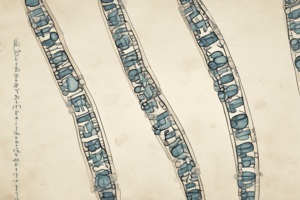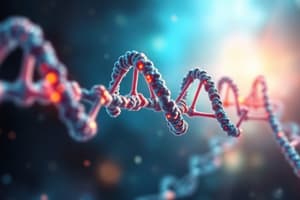Podcast
Questions and Answers
What is the primary consequence of mutations in an organism?
What is the primary consequence of mutations in an organism?
- Increased protein synthesis efficiency
- Enhanced adaptability to environmental changes
- Decreased genetic variability
- Inability to synthesize one or more proteins (correct)
What characterizes spontaneous mutations?
What characterizes spontaneous mutations?
- They occur by chance during DNA replication (correct)
- They are caused by environmental factors exclusively
- They are predictable and regularly occur
- They always lead to beneficial adaptations
During which process do spontaneous mutations most commonly occur?
During which process do spontaneous mutations most commonly occur?
- Protein synthesis
- Gene expression
- DNA replication (correct)
- Cell division
What effect can a mutation have on an organism's ability to produce proteins?
What effect can a mutation have on an organism's ability to produce proteins?
Which statement is true regarding the occurrence of spontaneous mutations?
Which statement is true regarding the occurrence of spontaneous mutations?
What primary function does the cytosol serve in the cell?
What primary function does the cytosol serve in the cell?
Which of the following components is NOT found in the cytosol?
Which of the following components is NOT found in the cytosol?
Which of the following accurately describes the composition of cytosol?
Which of the following accurately describes the composition of cytosol?
Why is cytosol essential for reproduction in cells?
Why is cytosol essential for reproduction in cells?
What characteristic of cytosol contributes to its function in the cell?
What characteristic of cytosol contributes to its function in the cell?
Which of the following is NOT considered a mutagen?
Which of the following is NOT considered a mutagen?
What type of radiation is included in the definition of mutagens?
What type of radiation is included in the definition of mutagens?
Which of the following statements about induced mutations is true?
Which of the following statements about induced mutations is true?
Which mutagen is known to be a biological agent?
Which mutagen is known to be a biological agent?
What is the primary consequence of exposure to mutagens?
What is the primary consequence of exposure to mutagens?
Which structure is specifically described as a sticky, sugary envelope surrounding the cell?
Which structure is specifically described as a sticky, sugary envelope surrounding the cell?
Which of the following structures is not a primary taxonomic character in some species?
Which of the following structures is not a primary taxonomic character in some species?
What are fimbriae primarily associated with in certain strains of species?
What are fimbriae primarily associated with in certain strains of species?
Which of the following statements is true regarding the structures present in some strains of some species?
Which of the following statements is true regarding the structures present in some strains of some species?
Which structure listed below is commonly found in bacteria but not necessarily in all species?
Which structure listed below is commonly found in bacteria but not necessarily in all species?
What role do plasmids play in bacterial adherence to host tissues?
What role do plasmids play in bacterial adherence to host tissues?
Which type of toxins are associated with plasmids in bacteria?
Which type of toxins are associated with plasmids in bacteria?
What is one function of Pili (fimbriae) in pathogenic bacteria?
What is one function of Pili (fimbriae) in pathogenic bacteria?
Which statement about plasmids is true?
Which statement about plasmids is true?
What is the significance of the genes located on plasmids for pathogenic bacteria?
What is the significance of the genes located on plasmids for pathogenic bacteria?
What distinguishes monotrichous bacteria from other types?
What distinguishes monotrichous bacteria from other types?
Which statement accurately describes lophotrichous bacteria?
Which statement accurately describes lophotrichous bacteria?
In the classification of bacteria, what is the primary feature used to differentiate monotrichous and lophotrichous types?
In the classification of bacteria, what is the primary feature used to differentiate monotrichous and lophotrichous types?
Which of the following best describes the flagellar arrangement of bacteria that are classified as monotrichous?
Which of the following best describes the flagellar arrangement of bacteria that are classified as monotrichous?
Why might a bacterium with a lophotrichous arrangement have an advantage over a monotrichous bacterium?
Why might a bacterium with a lophotrichous arrangement have an advantage over a monotrichous bacterium?
Flashcards
Cytosol's composition
Cytosol's composition
Cytosol is a water-based solution containing ions, small molecules, and macromolecules.
Cytosol's function
Cytosol's function
Cytosol contains mechanisms for maintaining cell health and reproduction.
Cytoplasm component
Cytoplasm component
Cytosol is a key part of the cytoplasm.
Watery substance
Watery substance
Signup and view all the flashcards
Cell maintenance
Cell maintenance
Signup and view all the flashcards
Spontaneous Mutation
Spontaneous Mutation
Signup and view all the flashcards
Protein Synthesis
Protein Synthesis
Signup and view all the flashcards
Mutation Effect
Mutation Effect
Signup and view all the flashcards
DNA Replication
DNA Replication
Signup and view all the flashcards
Mutation Cause
Mutation Cause
Signup and view all the flashcards
Induced Mutations
Induced Mutations
Signup and view all the flashcards
Mutagens
Mutagens
Signup and view all the flashcards
Types of Mutagens
Types of Mutagens
Signup and view all the flashcards
Mutation
Mutation
Signup and view all the flashcards
Radiation and Mutations
Radiation and Mutations
Signup and view all the flashcards
Pili Formation
Pili Formation
Signup and view all the flashcards
Bacterial Adherence
Bacterial Adherence
Signup and view all the flashcards
Plasmid Genes
Plasmid Genes
Signup and view all the flashcards
Exotoxins
Exotoxins
Signup and view all the flashcards
Enterotoxins
Enterotoxins
Signup and view all the flashcards
Glycocalyx
Glycocalyx
Signup and view all the flashcards
Bacterial Structures
Bacterial Structures
Signup and view all the flashcards
Flagella
Flagella
Signup and view all the flashcards
Inclusion Granules
Inclusion Granules
Signup and view all the flashcards
Sex Pili
Sex Pili
Signup and view all the flashcards
Monotrichous Bacteria
Monotrichous Bacteria
Signup and view all the flashcards
Lophotrichous Bacteria
Lophotrichous Bacteria
Signup and view all the flashcards
Flagellum Location
Flagellum Location
Signup and view all the flashcards
Bacterial Flagella
Bacterial Flagella
Signup and view all the flashcards
Bacterial Movement Types
Bacterial Movement Types
Signup and view all the flashcards
Study Notes
Bacterial Cell Structure and Function
- Bacteria are minute, single-celled organisms with diverse shapes (cocci, bacilli, spirals).
- Bacteria range in size from 0.2 to 2.0 µm in diameter and 2 to 8 µm in length.
- Essential structures present in all bacteria:
- Cytoplasm containing ribosomes.
- Cytoplasmic membrane (plasma membrane).
- Rigid cell wall (except in mycoplasmas).
- Nucleoid (circular chromosome).
- Structures present in some bacteria (variable features):
- Flagella.
- Spores.
- Inclusion granules.
- Fimbriae.
- Sex pili.
- Glycocalyx (capsule or slime layer).
Glycocalyx
- A sticky, sugary layer (polysaccharides/polypeptides) surrounding the bacteria.
- Can be firmly attached (capsule) or loosely attached (slime layer).
- Aids in adherence to surfaces, crucial in biofilms.
- Important for pathogenicity.
Cell Wall
- The outermost layer, common to all bacteria except Mycoplasma.
- Rigid structure made of peptidoglycan.
- Provides shape and protection for the cell.
- Gram-positive bacteria have a thicker peptidoglycan layer than gram-negative bacteria; also have teichoic acid.
Cytoplasmic Membrane
- Encloses the cytoplasm and organelles.
- Controls passage of molecules into and out of the cell (selective permeability barrier).
- Site of enzyme and toxin secretion.
Flagella
- Long, whip-like appendages that allow bacteria to move.
- Composed of protein and powered by a motor within the cell membrane.
- Various arrangements (monotrichous, lophotrichous, amphitrichous, peritrichous) depending on the position and number on the bacterium.
Fimbriae and Pili
- Short, hair-like appendages found on the bacterial surface.
- Used for attachment to surfaces, host cells, and other bacteria.
- Sex pili are longer and used for DNA transfer (conjugation).
Ribosomes
- Sites of protein synthesis.
- 70S in bacteria (50S and 30S subunits).
- Different from eukaryotic ribosomes (80S).
- Target of some antibiotics.
Mesosomes
- Infoldings of the cytoplasmic membrane.
- Involved in cell division.
Cytoplasm
- Gel-like substance inside the cell, containing ions, molecules, and macromolecules.
- Contains machinery for cell maintenance and reproduction.
Granules
- Storage structures within the cytoplasm, used for nutrient storage.
Nucleoid (Bacterial Chromosome)
- Single, circular DNA molecule.
- Contains the genetic material responsible for reproduction, metabolism, and other cell functions.
Nucleic Acids (DNA and RNA)
- Two main types: DNA (deoxyribonucleic acid) and RNA (ribonucleic acid).
- DNA: double helix, deoxyribose sugar, specific base pairing (A-T, G-C).
- RNA: single helix, ribose sugar, uracil instead of thymine.
- Different types of RNA: mRNA (messenger), tRNA (transfer), rRNA (ribosomal).
Mutations
- Permanent change in DNA sequence.
- Can affect the phenotype (observable characteristics).
- Types: substitution, insertion, deletion.
- Can be spontaneous or induced by chemical or environmental agents.
Bacterial Genetic Recombination
- Exchange of genetic material between bacteria.
- Mechanisms: transformation, transduction, conjugation.
Plasmids
- Extra-chromosomal, circular DNA molecules that replicate independently.
- Can carry genes for antibiotic resistance, toxin production, and other traits.
- Often involved in horizontal gene transfer between bacteria.
Spores
- Dormant survival structures formed by some bacteria.
- Highly resistant to environmental stressors (heat, radiation, chemicals).
- Can germinate into vegetative cells when conditions improve.
Studying That Suits You
Use AI to generate personalized quizzes and flashcards to suit your learning preferences.




